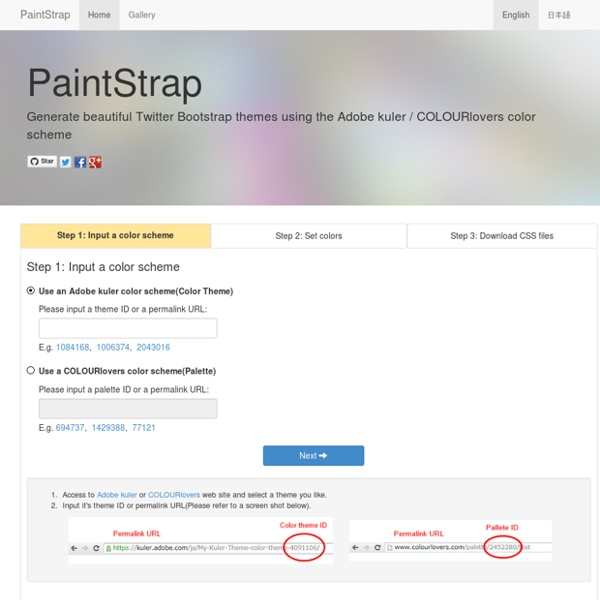



Beautiful Buttons for Twitter Bootstrappers This is an extension to the Twitter Bootstrap framework. It makes creating pretty buttons easy. (Send improvements to @charliepark.) BootTheme : Web Designer and Theme Generator for Twitter Bootstrap 18 Essential Bootstrap UI Editors Bootstrap has exploded since Twitter released it in 2011, becoming one of the most popular responsive frameworks available. It boasts an extensive library of pre-styled components, plugins and add-ons that make kickstarting your next web project a breeze. There is no shortage of Bootstrap resources, but in this post, we will focus on the editing tools that allow you to customize the framework to suit your requirements. We gathered 18 of the best free and paid Bootstrap editors, available online or as desktop tools, to help boost your web development productivity. Are there any Bootstrap editors that you use and would recommend?
Bootswatch: Free themes for Twitter Bootstrap 80+ AJAX-Solutions For Professional Coding Web-developers can create amazing web-applications with AJAX. Stikkit1, Netvibes2, GMail3 and dozens of further web-projects offer a new level of interactivity we’ve used to give up the idea of. Modern web-applications can be designed with enhanced user interfaces and functionalities, which used to be the privelege of professional desktop-applications. AJAX makes it possible to create more interactive, more responsive and more flexible web-solutions. And it’s the first step towards rich internet applications of the future.
#c2a2b2 hex color In a RGB color space, hex #c2a2b2 is composed of 76.1% red, 63.5% green and 69.8% blue. Whereas in a CMYK color space, it is composed of 0% cyan, 16.5% magenta, 8.2% yellow and 23.9% black. It has a hue angle of 330 degrees, a saturation of 20.8% and a lightness of 69.8%. Dottoro Slider Demo Since popup slideshows are needed on almost every website, the theme comes with a couple of predefined popup slideshows that are designed to meet the most common needs. They are fully responsive meaning they auto-adjust depending on the screen size of the device in both directions, horizontally and vertically. Builtin popup slideshows are readonly, but with the help of premade slider configurations (profiles) you can easily create custom ones. Check out the predefined popups slideshows by clicking on the plus sign appearing over the images. How to add an image to the content of a page/post that opens a popup slideshow when the user click on it?
Material Design Color Palette Generator - Material Palette material palette Material Design Examples Palette preview Full Palette colors below Improve Your Email Workflow With Modular Design Whether you’re in a Fortune 500 company or part a two-person team launching your first web app, email is one of the most important tools for reaching your customer base. But with the ever-growing number1 of emails to send2, getting them all out the door can seem a little overwhelming. By putting in place a solid email design workflow, you’ll be able to regularly ship engaging and mobile-friendly emails with ease. Complexity Meets Adaptation Link In addition to the increasing number of emails, the need for personalization and high quality and the introduction of responsive design have turned what was once a simple process of writing HTML and CSS in your favorite text editor into something seemingly more complex.
Behind The Responsive Redesign Of Kremlin.ru Relaunching a large-scale website is always quite an undertaking, especially if the task involves a huge political entity with content accumulated over a dozen years. In this article, we look behind the scenes of the responsive redesign of Kremlin.ru41, Russia’s most prominent government website. We had an opportunity to talk with Artyom Geller2, one of the creative minds responsible for the design and UX of the project. Building With Gulp Optimizing your website assets and testing your design across different browsers is certainly not the most fun part of the design process. Luckily, it consists of repetitive tasks that can be automated with the right tools to improve your efficiency. Gulp is a build system that can improve how you develop websites by automating common tasks, such as compiling preprocessed CSS, minifying JavaScript and reloading the browser. In this article, we’ll see how you can use Gulp to change your development workflow, making it faster and more efficient. What Is Gulp? Link